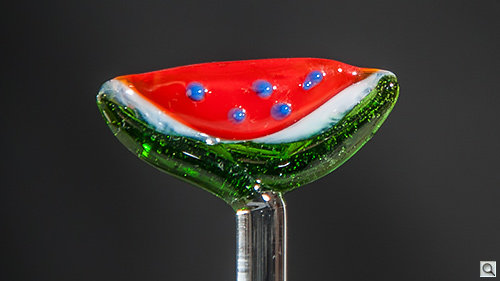Photo Corners headlinesarchivemikepasini.com
![]()
A S C R A P B O O K O F S O L U T I O N S F O R T H E P H O T O G R A P H E R
![]()
Enhancing the enjoyment of taking pictures with news that matters, features that entertain and images that delight. Published frequently.
Friday Slide Show: Glass Swizzle Sticks




7 July 2017
Once upon a time, we were browsing a little store on Sacramento St. that offered kitchenware among its items when we spied these inexpensive glass swizzle sticks. If we recall, they were made in Mexico and were about $2 each.
They're no Chihuly but we fell in love with them and gathered one up of each without thinking about it. In the 20+ years since we bought them, though, we've thought about it a lot.
Glass swizzle sticks? In the hands of the impaired?
We aren't big drink mixers so we never really had to deny anybody the use of them but they've patiently posed with the bar tools in a corner of the dining room all these years.
We did once try photographing them with the Nikon 990. Lit from behind in Macro mode, it made an attractive arrangement. We promised to do it right one day, but we never really got around to it.
Until this morning. And it was an adventure.
LIGHTING
The glass of swizzle sticks is not all quite the same type. Some of them are mostly opaque and then there are the completely transparent ones. Some opaque ones do have a bit of transparency, like the onion's leaves on its opaque white body.
So you need a mix of light. Some coming from behind to light up the transparent glass, some coming from in front to give the opaque glass volume.
There are lots of techniques and formulas for lighting setups but once you've understood how the game is played, you wing it.
We shot the set with a monobloc set up behind the subject. The monobloc light was diffused through two white scrims we just happened to have laying around.

Nikon 990 Macro. An early attempt from 2000.
And that worked fine for the transparent sticks.
But it was a disaster for the opaque ones. They were nearly silhouetted, all in shadow.
We tried adding a white reflector in front but that was too weak. We could have gone to two lights but we wanted to keep this project simple.
We got our Nikon SB-800 out and tried a few straight off-camera strobe exposures to experiment. The strobe is a lot more nimble than a monobloc on its light stand so we were able to figure pretty quickly what to do.
We replaced the white scrim background with a black fabric background (it was a book bag dropped over our white foam board reflector that stood straight up thanks to a small clamp if you must know).
Then we got a white dinner plate (don't tell anyone, please) from the kitchen and held that up to reflect the light from the strobe back through the stick.
We modified both the position of the strobe and the position of the plate for each subject depending on what we wanted to illuminate. It was a little like painting.
With our third hand.... Well, that was the problem. Only two hands.
Solved by, you guessed didn't you, the self timer. Ten seconds was a little too long so we reset it to two seconds. That was a little fast, but we managed.
And it was fun.
POSING
Getting our subjects to stand up straight and not fall over (they're swizzle sticks, remember) was a trick that required an engineering degree. But we didn't have time for an engineer to figure it out, so we, well, winged it.
We used a bud vase into which we stuffed a paper towel to provide a base. Not an even base, just a lumpy base that the bottom of the stick could nestle into.
The we made a donut of another paper towel and slipped that into the neck of the vase.
All we had to do was thread the stick through the donut hole to a nook in the towel at the bottom.
EXPOSURE
We tried three different lenses from a reversed 35mm to Lensbaby Edge 80 to our 18-200mm Nikkor (which was used for these images).

Macro Shot. A reversed 35mm lens gave us too tight a crop but we liked it.
We used the fastest sync speed on our camera (1/125 second) and opened the lens up.
We did use a circular polarizer to cut down on reflections and glare.
And we took advantage of Nikon's Creative Lighting System to fire the hand-held, off-camera SB-800 with the Nikon D300's pop-up flash.
But the self-timer came in, uh, handy, too, as we've explained.
POST
The 60 NEF Raw images were converted into DNGs before importing into Lightroom for cropping and a little tweaking. But not much.
Don't worry, the slide show has only 17 images. We start with the transparent swizzle sticks illuminated from behind by the monobloc and end up with the strobe and dinner plate set.
CONCLUSION
After all that you probably think we need a drink. We do, we do. But not quite yet. We want to take a look at that slide show again.
